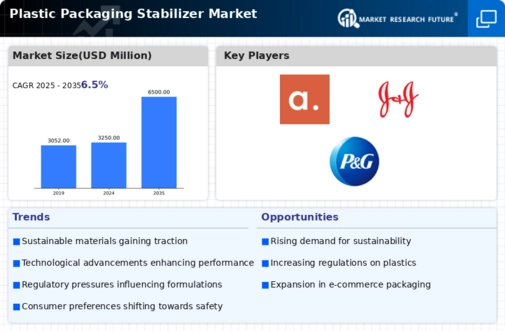Rising Demand for Eco-Friendly Packaging
The increasing consumer preference for sustainable products is driving the Plastic Packaging Stabilizer Market. As environmental concerns gain prominence, manufacturers are compelled to adopt eco-friendly materials and stabilizers that enhance the recyclability of plastic packaging. This shift is reflected in the market, where the demand for biodegradable and compostable packaging solutions is on the rise. According to recent data, the market for sustainable packaging is projected to grow at a compound annual growth rate of over 10% in the coming years. Consequently, the integration of advanced stabilizers that support these eco-friendly initiatives is becoming essential for companies aiming to meet consumer expectations and regulatory standards.
Growth in E-Commerce and Food Delivery Services
The surge in e-commerce and food delivery services has significantly impacted the Plastic Packaging Stabilizer Market. With the increasing volume of online shopping, there is a heightened need for durable and protective packaging solutions that ensure product integrity during transit. This trend has led to a notable increase in the demand for stabilizers that enhance the performance of packaging materials. Market data indicates that the e-commerce packaging segment is expected to witness a growth rate of approximately 15% annually. As a result, manufacturers are focusing on developing stabilizers that not only improve the shelf life of products but also cater to the specific requirements of various sectors, including food and pharmaceuticals.
Technological Innovations in Packaging Solutions
Technological advancements are playing a pivotal role in shaping the Plastic Packaging Stabilizer Market. Innovations in polymer chemistry and material science have led to the development of new stabilizers that enhance the performance and longevity of plastic packaging. These advancements enable manufacturers to create packaging solutions that are not only more effective but also align with sustainability goals. The market is witnessing a trend towards the use of nanotechnology and bio-based stabilizers, which are gaining traction due to their superior properties. As a result, the industry is expected to see a significant increase in the adoption of these innovative solutions, with market analysts projecting a growth rate of around 8% in the next five years.
Increasing Regulatory Pressure for Safety Standards
The Plastic Packaging Stabilizer Market is experiencing heightened regulatory scrutiny aimed at ensuring product safety and environmental compliance. Governments and regulatory bodies are implementing stringent guidelines regarding the use of additives and stabilizers in packaging materials. This regulatory landscape compels manufacturers to invest in high-quality stabilizers that meet safety standards while also being environmentally friendly. Recent data suggests that compliance with these regulations is becoming a critical factor for market players, influencing their choice of materials and stabilizers. As a result, the industry is likely to see a shift towards more compliant and safer packaging solutions, which could drive innovation and investment in the development of advanced stabilizers.
Consumer Awareness and Education on Packaging Materials
There is a growing trend of consumer awareness regarding the implications of packaging materials on health and the environment, which is influencing the Plastic Packaging Stabilizer Market. As consumers become more educated about the potential hazards associated with certain stabilizers and additives, they are increasingly demanding transparency from manufacturers. This shift is prompting companies to reformulate their products and adopt safer, more sustainable stabilizers. Industry expert's indicates that brands that prioritize consumer education and transparency are likely to gain a competitive edge. Consequently, the industry is expected to evolve, with a focus on developing stabilizers that not only meet performance criteria but also align with consumer expectations for safety and sustainability.


















Leave a Comment